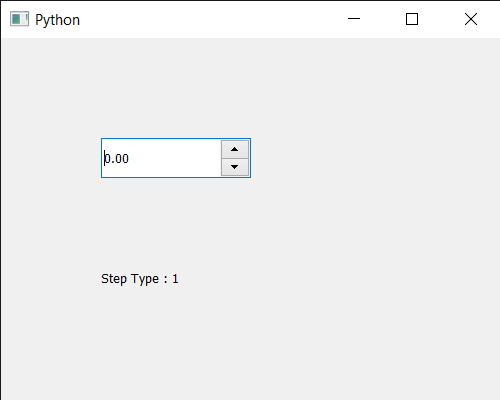En este artículo veremos cómo podemos obtener la propiedad de tipo de paso del QDoubleSpinBox. Esta propiedad contiene el tipo de paso. El tipo de paso puede ser paso único o paso decimal adaptativo. De forma predeterminada, cuando cambiamos el valor, cambia por un número entero, no por el valor decimal, aunque podemos cambiar esto con la ayuda de la propiedad de tipo de paso, se puede configurar con la ayuda del setStepTypemétodo.
Para hacer esto, usaremos stepTypeel método con el objeto QDateTimeEdit.
Sintaxis: dd_spin.stepType()
Argumento: no requiere argumento
Retorno: Devuelve un objeto de tipo de paso, pero cuando se imprime muestra el valor asociado con él.
A continuación se muestra la implementación.
# importing libraries
from PyQt5.QtWidgets import *
from PyQt5 import QtCore, QtGui
from PyQt5.QtGui import *
from PyQt5.QtCore import *
import sys
class Window(QMainWindow):
def __init__(self):
super().__init__()
# setting title
self.setWindowTitle("Python ")
# setting geometry
self.setGeometry(100, 100, 500, 400)
# calling method
self.UiComponents()
# showing all the widgets
self.show()
# method for components
def UiComponents(self):
# creating double spin box
d_spin = QDoubleSpinBox(self)
# setting geometry to the double spin box
d_spin.setGeometry(100, 100, 150, 40)
# step type
step_type = QAbstractSpinBox.AdaptiveDecimalStepType
# adaptive step type
d_spin.setStepType(step_type)
# creating a label
label = QLabel("GeeksforGeeks", self)
# setting geometry to the label
label.setGeometry(100, 200, 300, 80)
# making label multi line
label.setWordWrap(True)
# getting step type
value = d_spin.stepType()
# setting text to the label
label.setText("Step Type : " + str(value))
# create pyqt5 app
App = QApplication(sys.argv)
# create the instance of our Window
window = Window()
# start the app
sys.exit(App.exec())
Producción :
Publicación traducida automáticamente
Artículo escrito por rakshitarora y traducido por Barcelona Geeks. The original can be accessed here. Licence: CCBY-SA